Citheronia Hybrids
by Nathan Boob
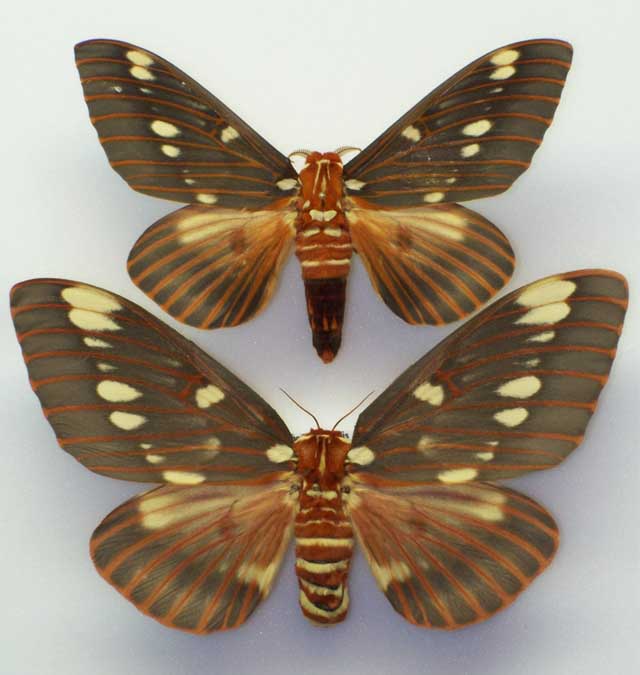
Citheronia regalis x Citheronia splendens sinaloensis hybrids,
male and female, courtesy of Nathan Boob.

Citheronia regalis x Citheronia splendens sinaloensis hybrids,
male and female, courtesy of Nathan Boob.
"Bill,
"I wanted to give you an update on my two hybrid projects this year. I think I may have mentioned the regalis x splendens sinaloensis pairings that I had. I had many pairings between both species, only the first one being hand paired.
"I kept ova from two pairings (regalis male x splendens female and splendens male x regalis female), and fertility was nearly 100% in both crosses. Larvae hatched normally and were sleeved outdoors on black walnut. I had very few losses and those were from soldier bugs attacking through the sleeves. They grew very rapidly as Citheronia do.
"Larvae had regalis and splendens traits through all instars with a few notable differences in the fifth between the two groups. The splendens male group were various shades of light tan with pinkish dorsal tubercles. Some larvae were black tipped like regalis. Those larva that had black tips also had black abdominal spines where the larva without black tips had pink spines. They all possessed the light markings under the spricales. Their overall appearance was that of a brown regalis larva. Four larva grew to the size of a regalis, but the rest were between regalis and splendens. The regalis male group were a dirty green with very large pink horns. All were tipped with black. They on average grew larger than the other group.
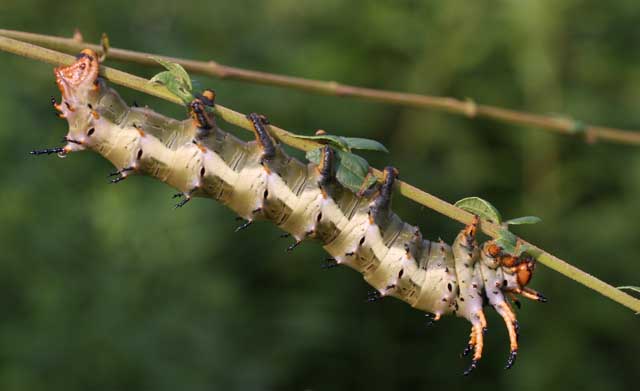
C. regalis x C. splendens sinaloensis fifth instar, Nathan Boob.
C. regalis x C. splendens sinaloensis fifth instar, Nathan Boob.
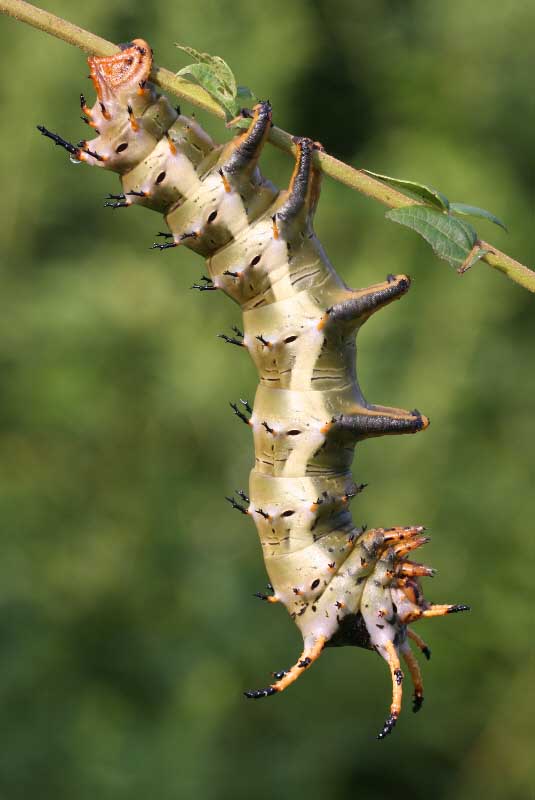
"Wandering larva were collected daily and placed in boxes of damp peat. After three days they were dug up and placed in another airtight plastic container with damp peat and misted heavily with water. All formed perfect pupae, 66 from the splendens male group and 65 from the other group. Pupae were somewhat rough textured like splendens with long cremasters. They are awaiting cold storage.
"I was very surprised when after four weeks a female emerged! A check of the pupae found about 12 that were soft. I moved them outdoors to my emergence cage and all came out. No other pupae emerged. I was surprised again when I felt the female's abdomens and found them full of ova! I hand paired the first two that emerged and had two other natural pairings. All three females produced full clutches of ova (<200>) with the natural pairings being 90% fertile. The hand pairing was unsuccessful. Larvae developed and hatched normally and I'm currently rearing about 100 on Staghorn sumac. Some larva lacked their saddle marking.
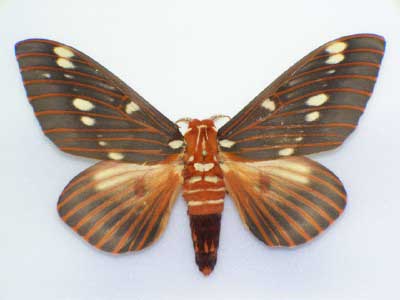
Hybrid male of Citheronia splendens sinaloensis x Citheronia regalis,
courtesy of Nathan Boob.
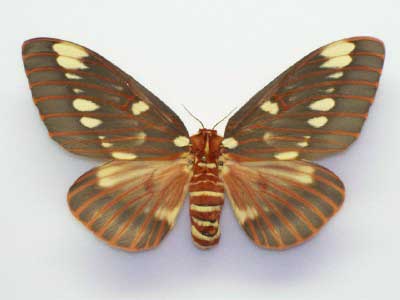
Hybrid female of Citheronia splendens sinaloensis x Citheronia regalis,
courtesy of Nathan Boob.
"Nathan,
"Really interesting.
"Hybrid crosses usually result in barren females. However, Hyalophora kasloensis is thought to be a self-sustaining hybrid of
Hyalophora euryalus and Hyalophora columbia gloveri.
"If the genetic match is close enough, I guess you get reproductively viable offspring. Hope you got some pictures.
"I believe Antheraea pernyi and Antheraea roylii produce a hybrid that also is fertile, called Antheraea proylei."
"Bill,
"I thought about kasloensis as well and am wondering if (after further testing next year) this hybrid might deserve species status??? I was unable to photograph the larva, but a friend who is a professional photographer did. I hope to get some photos to you soon. I did freeze the adults I didn't use for pairings. I will send some slides of an adult female hybrid as soon as I get them developed."
"Nathan,
"I am not sure that "proylei" is recognized as a species. It may be just a hybrid that spins a more usable silk than either A. roylii or
A. pernyi, and I am not sure how self-fertile it is."
Here are some photos of the Citheronia regalis x Citheronia splendens sinaloensis hybrid adults I reared in '08. The photo of the three together is a comparison of the hybrid (middle) and the two parent moths. (splendens sin. top, regalis bottom). The photo of the two together (top of page) is a hybrid pair and the singles are hybrid male and female. I hope to get the larva photos to you soon! Use them however you like.
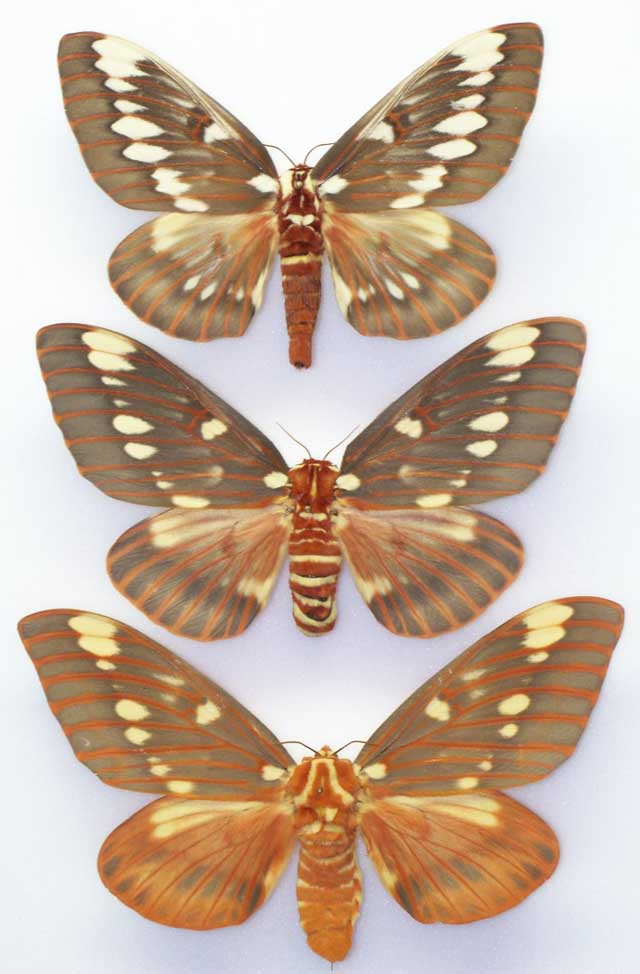
Citheronia sinaloensis top, hybrid (middle), Citheronia regalis botton,
females, courtesy of Nathn Boob.